Simulation Analysis of the Dispersion of Typical Marine Pollutants by Fusion of Multiple Processes
Abstract
1. Introduction
2. Multi-Process Fusion Simulation Analysis Method of Marine Pollutants
2.1. Pollutant Diffusion Process
2.2. Pollutant Transport Process
2.3. Pollutant Decay Process
2.4. Data Architecture
- Topographic elevation data: These data were used to distinguish sea surface and land surface boundaries during the simulation process. The ETOPO1 dataset used in this study is the most accurate elevation data released by NGDC, with a resolution of 1 min;
- Earth satellite image data: Earth satellite images and background maps provide information for the simulation of the diffusion process. The data volume is small, and the dimension is not related to time. The required images can be directly extracted from the website of the Visual Earth Digital Library;
- Flow field data: This data type provides important support for diffusion simulation in local areas and serves as the ocean current velocity data source for the simulation analysis of the pollutant transport process. The HYCOM data set used in this study contains ocean surface current velocities from 80° S to 80° N, with the data accuracy of 0.04° and 0.08° in the latitudinal and longitudinal directions, respectively. The time interval was 3 h, and the data accuracy was higher than that of the other ocean current data. The reliability analysis shown in Figure S1 in the supplementary material showed that the accuracy of HYCOM ocean current data is higher in high-velocity areas near China. Therefore, for the case study, the areas with higher current velocities in the South China Sea (105° E to 116° E in longitude and 11.5° N to 23° N in latitude) were selected for simulation and analysis to ensure the accuracy of the simulation results.
2.5. Data Processing and Fusion Analysis
3. Case Study
3.1. Basic Situation
3.2. Simulation Results Analysis
4. Discussion and Limitations
4.1. Discussion
- The diffusion process of pollutants was categorized into several independent sub-processes, thus expanding the scope of the analysis of the method is easy. For example, although this study considered the diffusion of a single pollution source in the South China Sea, the proposed method can be used for the diffusion analysis of multiple pollution sources. Because the diffusion processes are independent of each other, the simple superposition of each pollution source’s diffusion process is sufficient. Simultaneously, the proposed simulation method can also involve more sub-processes. For example, by introducing a microbial degradation coefficient after the completion of the diffusion and transport process simulations, the diffusion process of N, P, and other organic matter can be analyzed, thus providing good scalability.
- The proposed pollutant diffusion simulation method can be used for simulating any global marine area based on HYCOM data. Moreover, the method does not depend on specific ocean current models, and the ocean current dataset with arbitrary precision can be replaced according to the needs of the study, rendering the simulation process simple and efficient.
- In this study, the calculation process was simplified using grid division, diffusion velocity k value, and diffusion coefficient D, therefore eliminating the need for complex calculations, such as differentiation during the solving process. Hence, this method can reduce the number of calculations without considerably decreasing accuracy, therefore saving computational resources and shortening the simulation time.
4.2. Limitations
- The pollutant diffusion model proposed in this study is based on the assumption of planar diffusion and does not require the three-dimensional diffusion method, because the sea area near China is shallow, the inshore water depth is shallower, and the ocean depth is negligible compared with the plane simulation range. However, the disadvantage of this method is that the vertical transport of pollutants and the interaction between seafloor sediments are not considered, which decreases the accuracy of the model.
- In the key settings, this study considered some influencing factors of the diffusion coefficient D; however, in practice, this coefficient is affected by ocean currents, temperature, and other factors, and their value should be determined through further experiments.
- This study assumed that the sub-processes of the pollutant diffusion model are independent of each other; however, because the ocean is a typical complex system, the sub-processes may interact with each other and influence the actual pollutant diffusion processes, such as suspension adsorption, and the interaction between the atmosphere and the upper surface layer of the ocean. Furthermore, internal sinks, i.e., the enrichment and migration of marine organisms exert a certain degree of influence on the diffusion of pollutants. Specifically, for the diffusion of radioactive pollutants in the ocean, the effect of biological factors may be greater than that of the transport of ocean currents. Therefore, the negative effects on human beings cannot be determined only based on the pollutant concentration in seawater. Subsequently, relevant influence factors should be added or the corresponding biological form attenuation term should be set in the model.
4.3. Future Directions
- Modifying the two-dimensional diffusion analysis method to a three-dimensional diffusion method: In subsequent studies, the three-dimensional flow field at the ocean scale can be constructed using ocean current data at various depths in the HYCOM flow field data, which can support the application of the proposed method in three-dimensional diffusion simulations.
- Optimizing the marine pollutant diffusion model: The parameter value process should be further optimized, and the actual emission process should be tested and monitored to optimize the key parameter values of the model. Moreover, for higher accuracy simulation requirements, using higher-order differential equation-solving methods or more refined grid division methods for optimizing the analysis methods of each sub-process should be used in further studies. Furthermore, more appropriate ocean current models or data generation from monitoring should be considered for specific areas of the ocean.
- Considering the influence of more factors in the ocean: Future studies can consider exploring the environmental characteristics of the ocean comprehensively and subdividing the overall diffusion sub-process of different pollutants. Additionally, the influence of biological enrichment, coastal accumulation, vertical transport, air-sea interaction, and other factors on the simulation process should be considered.
5. Conclusions
Supplementary Materials
Author Contributions
Funding
Institutional Review Board Statement
Informed Consent Statement
Data Availability Statement
Conflicts of Interest
References
- Vardhan, K.H.; Kumar, P.S.; Panda, R.C. A review on heavy metal pollution, toxicity and remedial measures: Current trends and future perspectives. J. Mol. Liq. 2019, 290, 111197. [Google Scholar] [CrossRef]
- Eto, K. Pathology of Minamata disease. Toxicol. Pathol. 1997, 25, 614–623. [Google Scholar] [CrossRef] [PubMed]
- de Carvalho Machado, C.; Dinis-Oliveira, R.J. Clinical and Forensic Signs Resulting from Exposure to Heavy Metals and Other Chemical Elements of the Periodic Table. J. Clin. Med. 2023, 12, 2591. [Google Scholar] [CrossRef] [PubMed]
- Alimba, C.G.; Faggio, C. Microplastics in the marine environment: Current trends in environmental pollution and mechanisms of toxicological profile. Environ. Toxicol. Pharmacol. 2019, 68, 61–74. [Google Scholar] [CrossRef]
- Lin, X.; Tang, J.; Li, Z.; Li, H. Finite element simulation of total nitrogen transport in riparian buffer in an agricultural watershed. Sustainability 2016, 8, 288. [Google Scholar] [CrossRef]
- Guo, B.; Yang, P.; Zhou, Y.; Ai, H.; Li, X.; Kang, R.; Lv, Y. Numerical Simulation of Carbon Tetrachloride Pollution-Traceability in Groundwater System of an Industrial City. Sustainability 2022, 14, 16113. [Google Scholar] [CrossRef]
- Pang, M.; Song, W.; Zhang, P.; Shao, Y.; Li, L.; Pang, Y.; Wang, J.; Xu, Q. Research into the eutrophication of an artificial playground lake near the Yangtze River. Sustainability 2018, 10, 867. [Google Scholar] [CrossRef]
- Makri, P.; Stathopoulou, E.; Hermides, D.; Kontakiotis, G.; Zarkogiannis, S.D.; Skilodimou, H.D.; Bathrellos, G.D.; Antonarakou, A.; Scoullos, M. The Environmental Impact of a Complex Hydrogeological System on Hydrocarbon-Pollutants’ Natural Attenuation: The Case of the Coastal Aquifers in Eleusis, West Attica, Greece. J. Mar. Sci. Eng. 2020, 8, 1018. [Google Scholar] [CrossRef]
- Stewart, R.E.; Putnam, H.D.; Jones, R.H.; Lee, T.N. Diffusion of sewage effluent from ocean outfall. J. Sanit. Eng. Div. 1971, 97, 485–503. [Google Scholar] [CrossRef]
- Lam, D.; Murthy, C. Outfall diffusion models for the coastal zone. In Coastal Engeneering; American Society of Civil Engineers: Reston, VA, USA, 1978; pp. 2584–2597. [Google Scholar]
- Guerrini, F.; Mari, L.; Casagrandi, R. Microplastic as a vector of chemical contamination in the marine environment: A coupled Lagrangian-Eulerian approach. In Proceedings of the Global Oceans 2020: Singapore–U.S. Gulf Coast, Biloxi, MS, USA, 5–30 October 2020; pp. 1–7. [Google Scholar]
- Qin, R.; Lin, L.; Kuang, C.; Su, T.-C.; Mao, X.; Zhou, Y. A GIS-based software for forecasting pollutant drift on coastal water surfaces using fractional Brownian motion: A case study on red tide drift. Environ. Modell. Softw. 2017, 92, 252–260. [Google Scholar] [CrossRef]
- Gruber, N.; Hauri, C.; Lachkar, Z.; Loher, D.; Frölicher, T.L.; Plattner, G.-K. Rapid progression of ocean acidification in the California Current System. Science 2012, 337, 220–223. [Google Scholar] [CrossRef] [PubMed]
- Van Westen, R.M.; Dijkstra, H.A. Ocean eddies strongly affect global mean sea-level projections. Sci. Adv. 2021, 7, eabf1674. [Google Scholar] [CrossRef] [PubMed]
- DiNezio, P.N.; Tierney, J.E.; Otto-Bliesner, B.L.; Timmermann, A.; Bhattacharya, T.; Rosenbloom, N.; Brady, E. Glacial changes in tropical climate amplified by the Indian Ocean. Sci. Adv. 2018, 4, eaat9658. [Google Scholar] [CrossRef] [PubMed]
- Dunn, R.J.; Zigic, S.; Shiell, G.R. Modelling the dispersion of treated wastewater in a shallow coastal wind-driven environment, Geographe Bay, Western Australia: Implications for environmental management. Environ. Monit. Assess. 2014, 186, 6107–6125. [Google Scholar] [CrossRef]
- Souza, B.C.; Olival, C.A.; Endrigo, I.G.; Coelho, V.R.; Maalouf, S.; Zambon, R.C. Capacity Expansion Study of the Santos Ocean Outfall, Brazil. In Proceedings of the World Environmental and Water Resources Congress 2018: International Perspectives, History and Heritage, Emerging Technologies, and Student Papers, Minneapolis, MN, USA, 3–7 June 2018; pp. 325–335. [Google Scholar]
- Li, Y.S.; Pan, L.Z.; Yang, H. Simulation of pollutant discharge and diffusion in the Yangtze River Estuary. Chin. J. Oceanol. Limnol. 2014, 2, 9–14. [Google Scholar]
- Johannessen, O.M.; Volkov, V.A.; Pettersson, L.H.; Maderich, V.S.; Zheleznyak, M.J.; Gao, Y.; Bobylev, L.P.; Stepanov, A.V.; Neelov, I.A.; Tishkov, V.P.; et al. Generic Model System (GMS) for Simulation of Radioactive Spread in the Aquatic Environment; Springer: Berlin/Heidelberg, Germany, 2010; pp. 147–211. [Google Scholar]
- Busecke, J.J.; Abernathey, R.P. Ocean mesoscale mixing linked to climate variability. Sci. Adv. 2019, 5, eaav5014. [Google Scholar] [CrossRef]
- Prants, S.; Uleysky, M.Y.; Budyansky, M. Numerical simulation of propagation of radioactive pollution in the ocean from the Fukushima Dai-ichi nuclear power plant. Dokl. Earth. Sci. 2011, 439, 1179–1182. [Google Scholar] [CrossRef]
- Behrens, E.; Schwarzkopf, F.U.; Lübbecke, J.F.; Böning, C.W. Model simulations on the long-term dispersal of 137Cs released into the Pacific Ocean off Fukushima. Environ. Res. Lett. 2012, 7, 034004. [Google Scholar] [CrossRef]
- Lai, Z.; Chen, C.; Beardsley, R.; Lin, H.; Ji, R.; Sasaki, J.; Lin, J. Initial spread of 137 Cs from the Fukushima Dai-ichi Nuclear Power Plant over the Japan continental shelf: A study using a high-resolution, global-coastal nested ocean model. Biogeosciences 2013, 10, 5439–5449. [Google Scholar] [CrossRef]
- Liu, Y.; Guo, X.-Q.; Li, S.-W.; Zhang, J.-M.; Hu, Z.-Z. Discharge of treated Fukushima nuclear accident contaminated water: Macroscopic and microscopic simulations. Natl. Sci. Rev. 2022, 9, nwab209. [Google Scholar] [CrossRef]
- Heling, R. LAKECO: Modelling the transfer of radionuclides in a lake ecosystem. Radiat. Prot. Dosim. 1997, 73, 191–194. [Google Scholar] [CrossRef]
- Zheleznyak, M.; Shepeleva, T.; Sizonenko, V.; Mezhueva, I. Simulation of countermeasures to diminish radionuclide fluxes from the Chernobyl zone via aquatic pathways. Radiat. Prot. Dosim. 1997, 73, 181–186. [Google Scholar] [CrossRef]
- Zheleznyak, M.J.; Demchenko, R.I.; Khursin, S.L.; Kuzmenko, Y.I.; Tkalich, P.V.; Vitiuk, N.Y. Mathematical modeling of radionuclide dispersion in the Pripyat-Dnieper aquatic system after the Chernobyl accident. Sci. Total Environ. 1992, 112, 89–114. [Google Scholar] [CrossRef]
- Li, L.; Shuxue, L.; Jinxuan, L. Deterministic simulation of multidirectional irregular waves. Haiyang Xuebao 2020, 42, 79–86. [Google Scholar]
- Bijin, L.; Zhenwei, Z.; Zhongbo, L. Simulating the evolution of a focused wave group by a Boussinesq-type model. Haiyang Xuebao 2021, 43, 31–39. [Google Scholar]
- Dąbrowski, J.; Kulawiak, M.; Moszyński, M.; Bruniecki, K.; Kamiński, Ł.; Chybicki, A.; Stepnowski, A. Real-time web-based GIS for analysis, visualization and integration of marine environment data. In Information Fusion and Geographic Information Systems, Proceedings of the Fourth International Workshop, Saint Petersburg, Russia, 17–20 May 2009; Springer: Berlin/Heidelberg, Germany, 2009; pp. 277–288. [Google Scholar]
- Su, T.; Cao, Z.; Lv, Z.; Liu, C.; Li, X. Multi-dimensional visualization of large-scale marine hydrological environmental data. Adv. Eng. Softw. 2016, 95, 7–15. [Google Scholar] [CrossRef]
- He, Y.; Su, F.; Du, Y.; Xiao, R. Web-based spatiotemporal visualization of marine environment data. Chin. J. Oceanol. Limnol. 2010, 28, 1086–1094. [Google Scholar] [CrossRef]
- Zhang, F.; Mao, R.; Du, Z.; Liu, R. Spatial and temporal processes visualization for marine environmental data using particle system. Comput. Geotech. 2019, 127, 53–64. [Google Scholar] [CrossRef]
- Li, C.-X.; Zheng, C.-W. High-efficiency method for 3D visualization of marine environmental information. Earth Sci. Inform. 2023, 16, 367–377. [Google Scholar] [CrossRef]
- Liu, Y.; Zhang, J.-M.; Min, Y.-T.; Yu, Y.; Lin, C.; Hu, Z.-Z. A digital twin-based framework for simulation and monitoring analysis of floating wind turbine structures. Ocean Eng. 2023, 283, 115009. [Google Scholar] [CrossRef]
- CORE Hong Kong and Macau Ocean Research Center. CS Air-Sea-Biogeochemical Coupling in China. Available online: https://ocean.ust.hk:8443/SiteMapApi/new/index.jsp (accessed on 2 January 2023).
- Fick, A.J.A.d.P. Ueber diffusion. Ann. Phys. 1855, 170, 59–86. [Google Scholar] [CrossRef]
- National Centers for Environmental Information. ETOPO1 Global Relief Model. Available online: https://www.ngdc.noaa.gov/mgg/global/global.html (accessed on 20 December 2022).
- National Aeronautics and Space Administration. A Catalog of NASA Images and Animations of Our Home Planet. Available online: https://visibleearth.nasa.gov/collection/1484/blue-marble (accessed on 20 December 2022).
- Center for Ocean-Atmospheric Prediction Studies. HYbrid Coordinate Ocean Model. Available online: https://www.hycom.org/ (accessed on 1 January 2023).
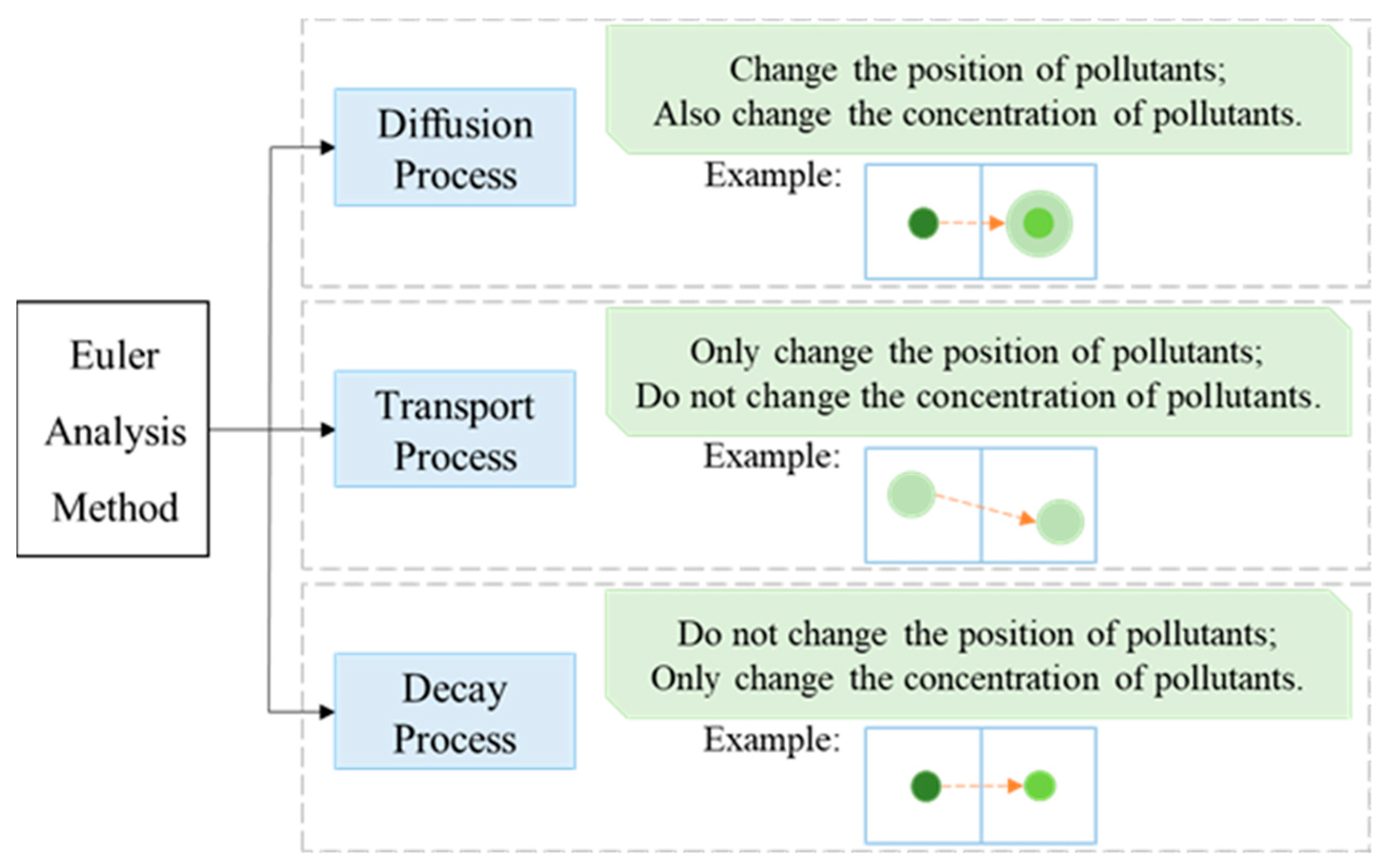

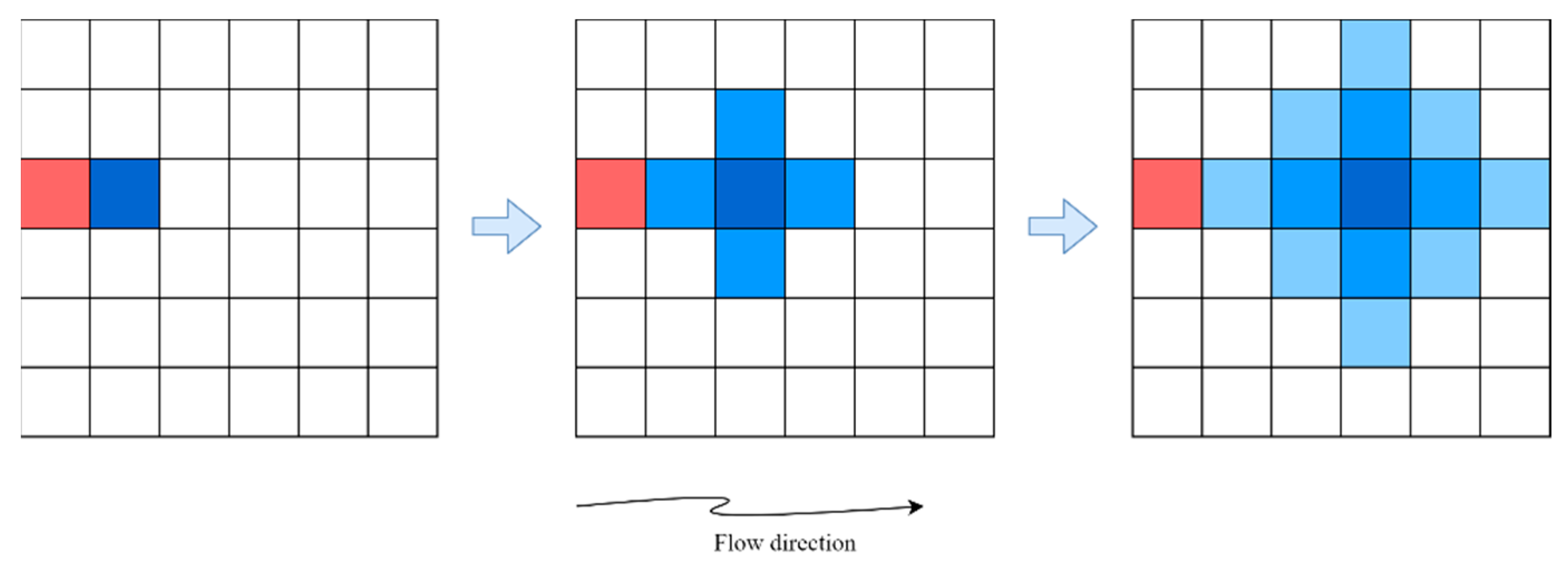
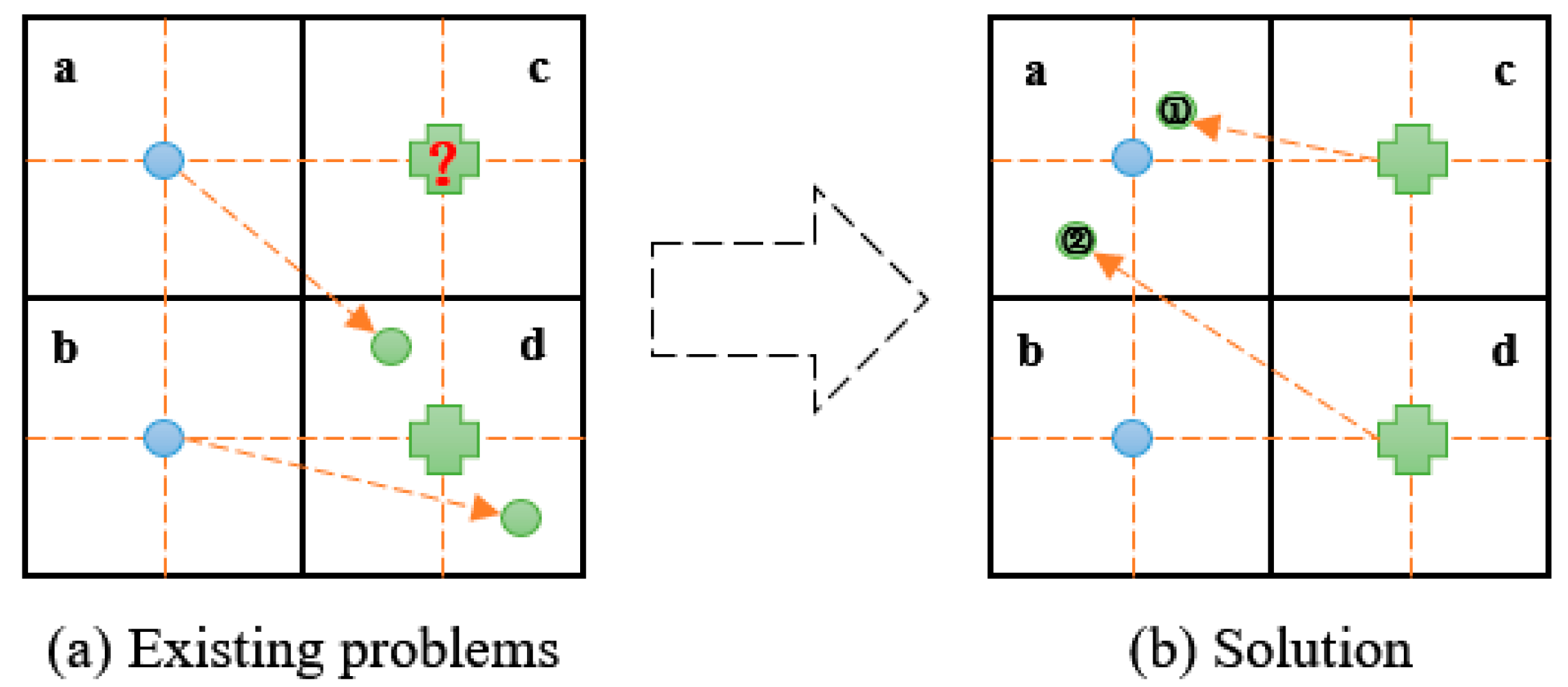
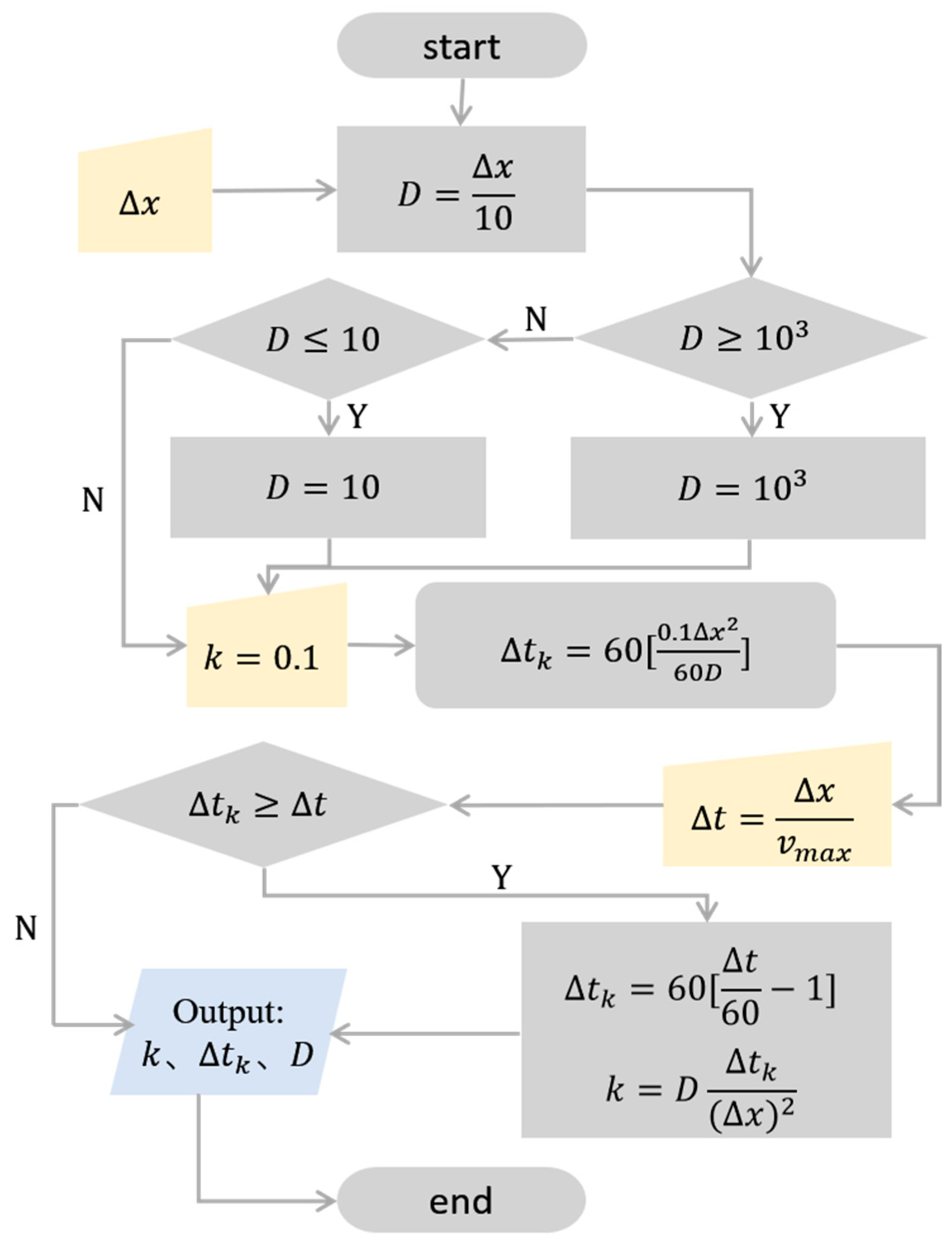

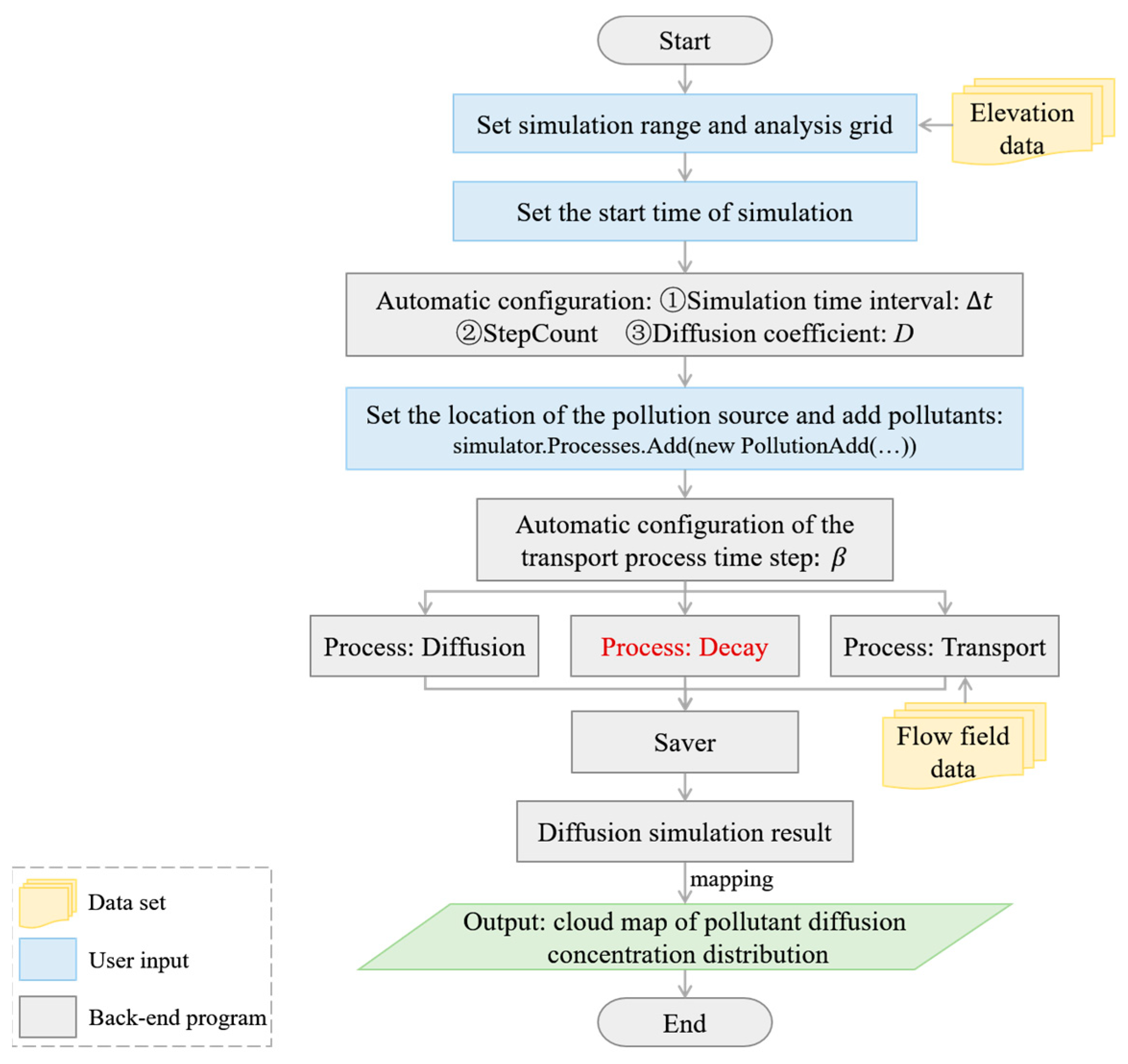
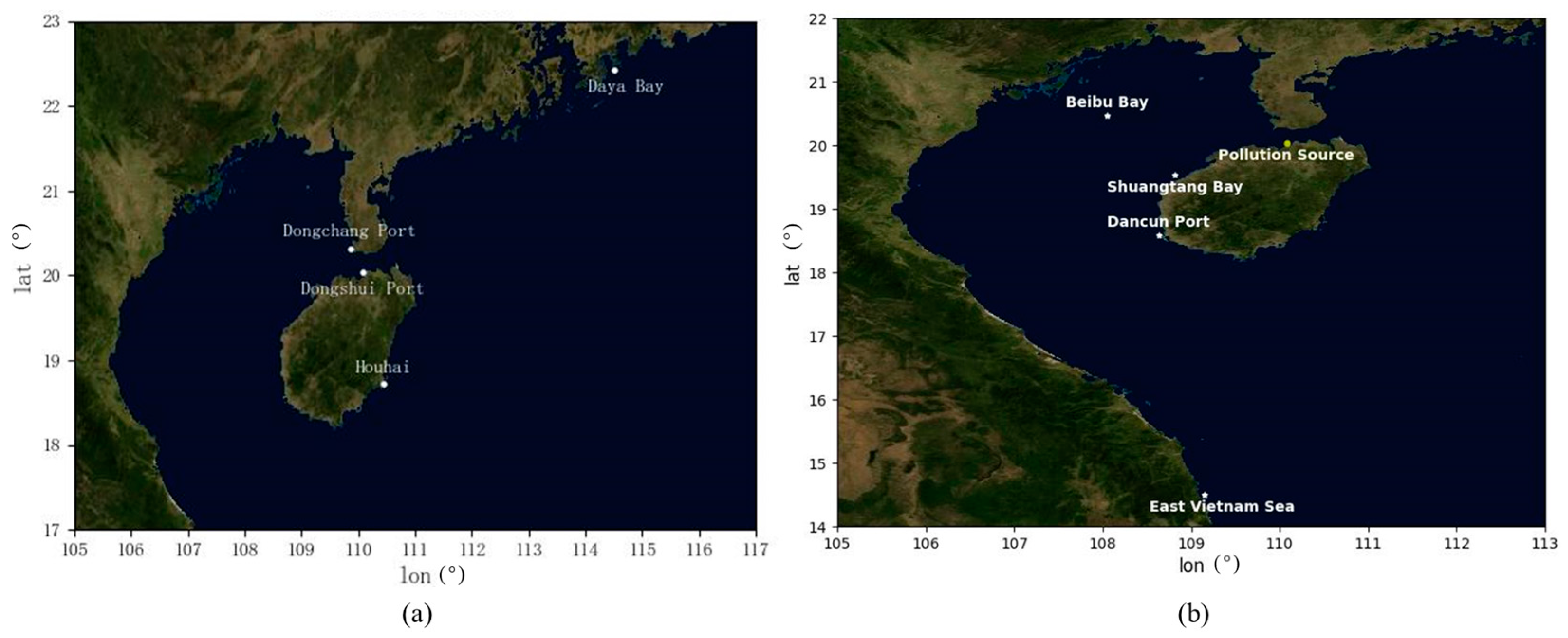
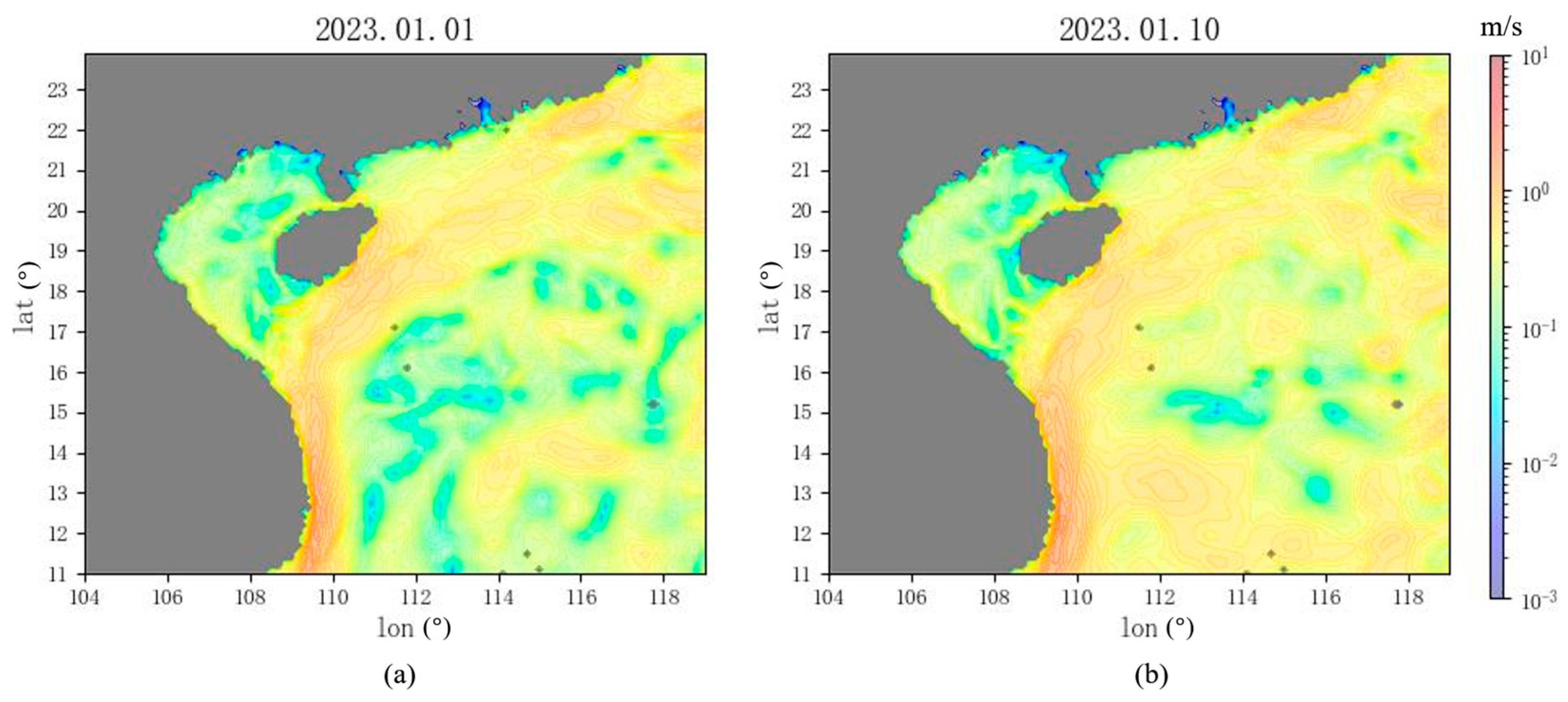
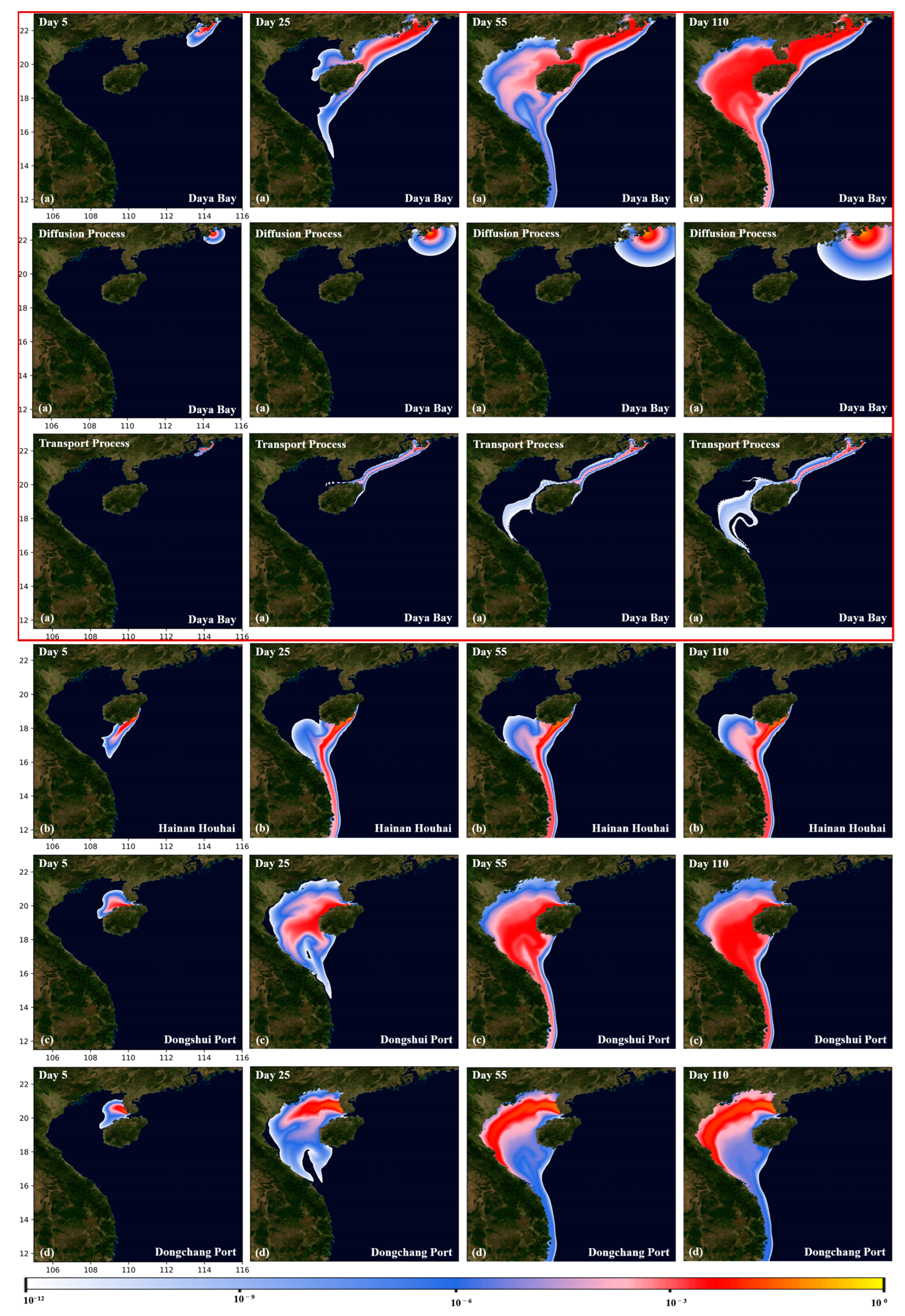
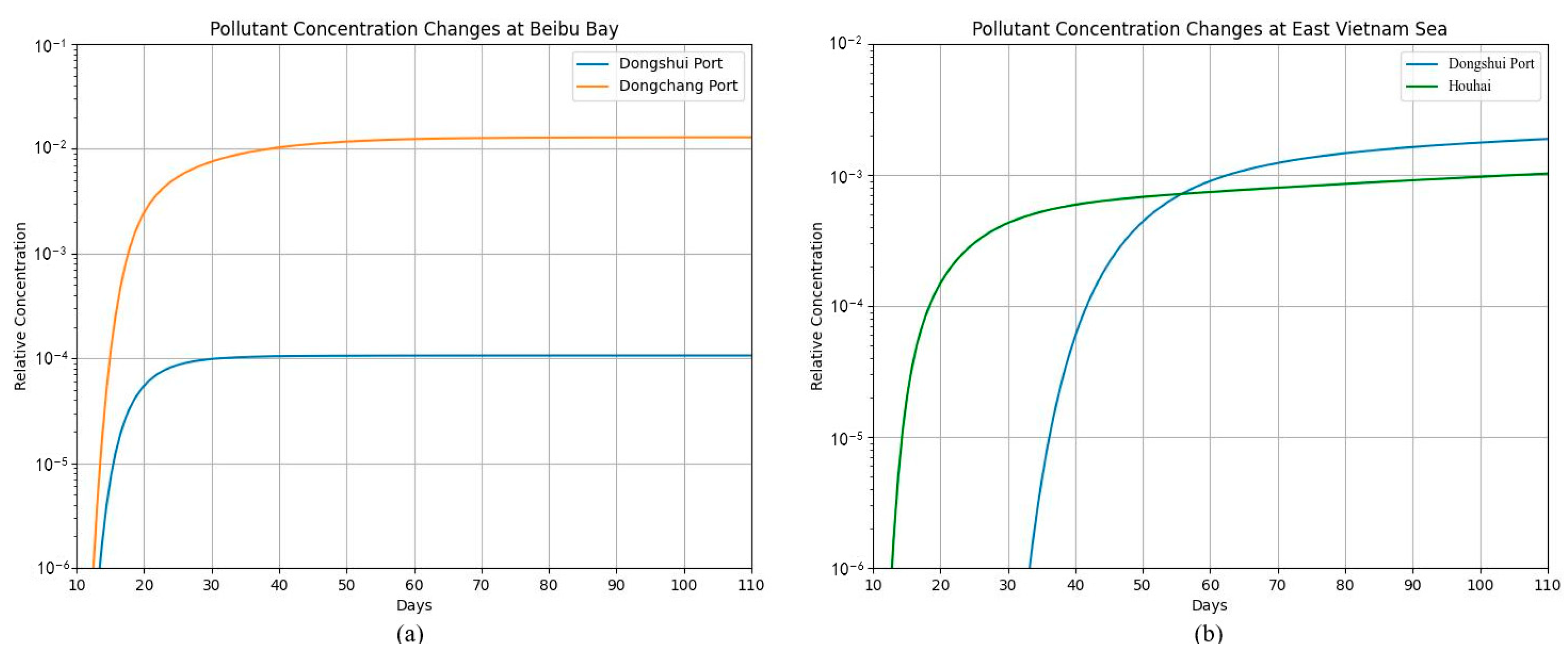
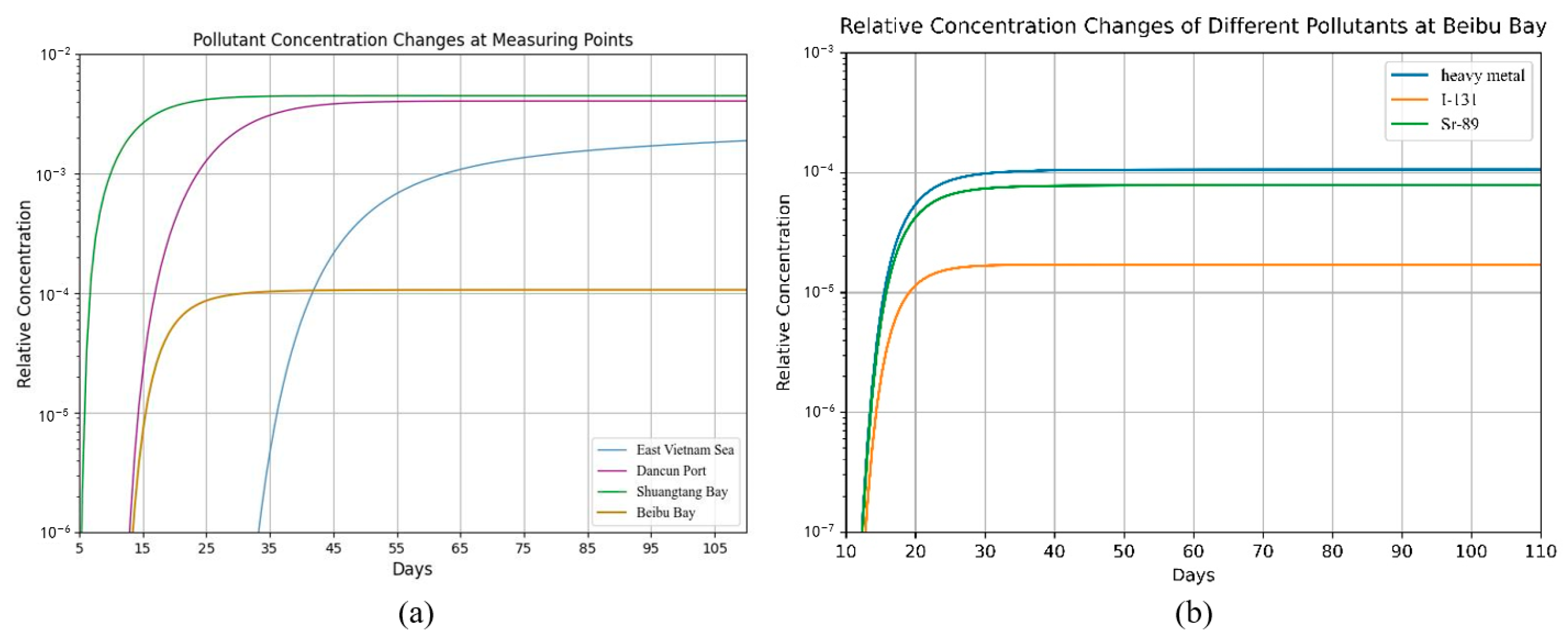
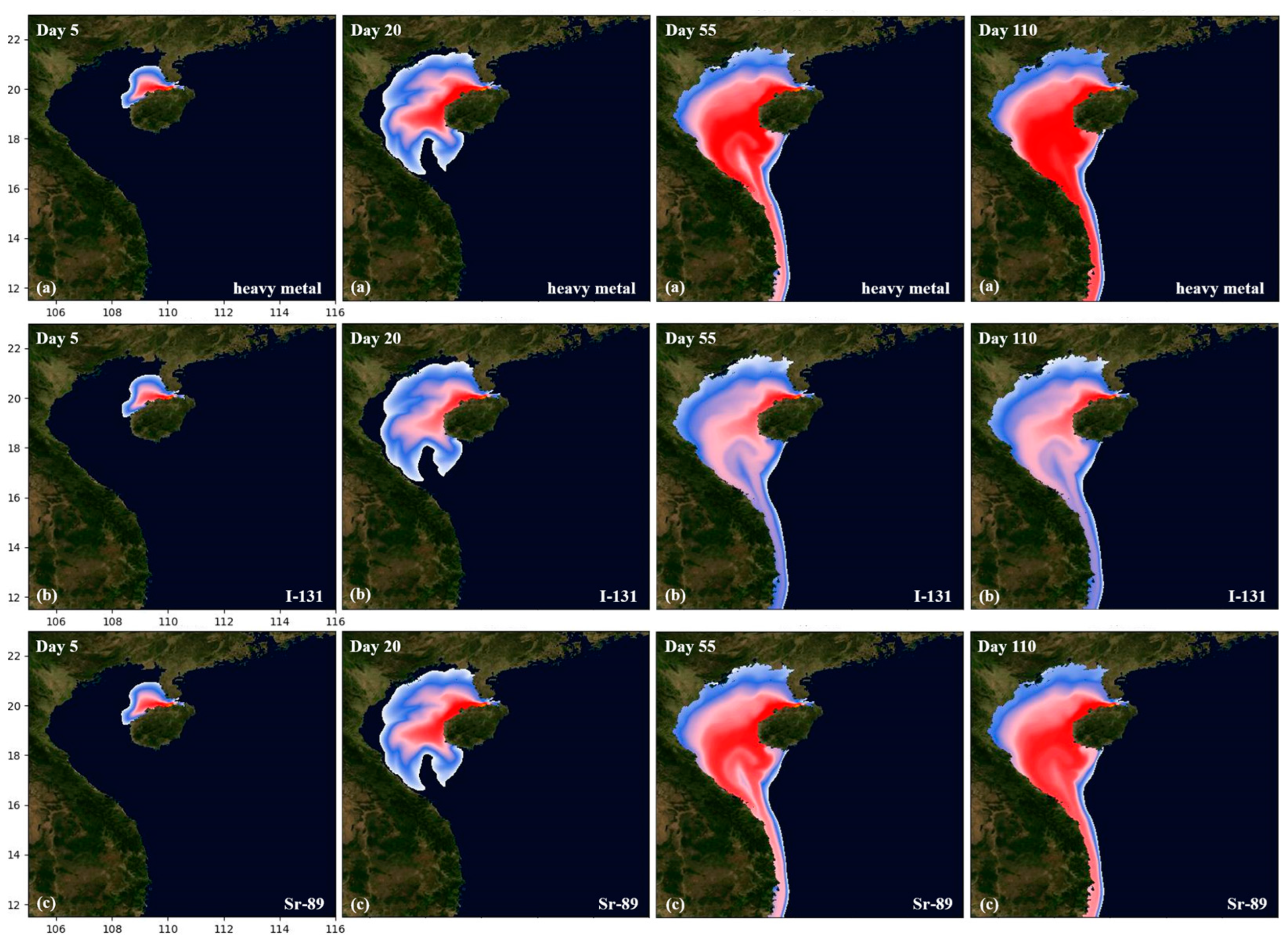
Disclaimer/Publisher’s Note: The statements, opinions and data contained in all publications are solely those of the individual author(s) and contributor(s) and not of MDPI and/or the editor(s). MDPI and/or the editor(s) disclaim responsibility for any injury to people or property resulting from any ideas, methods, instructions or products referred to in the content. |
© 2023 by the authors. Licensee MDPI, Basel, Switzerland. This article is an open access article distributed under the terms and conditions of the Creative Commons Attribution (CC BY) license (https://creativecommons.org/licenses/by/4.0/).
Share and Cite
Guo, X.; Liu, Y.; Zhang, J.-M.; Chen, S.; Li, S.; Hu, Z.-Z. Simulation Analysis of the Dispersion of Typical Marine Pollutants by Fusion of Multiple Processes. Sustainability 2023, 15, 10547. https://doi.org/10.3390/su151310547
Guo X, Liu Y, Zhang J-M, Chen S, Li S, Hu Z-Z. Simulation Analysis of the Dispersion of Typical Marine Pollutants by Fusion of Multiple Processes. Sustainability. 2023; 15(13):10547. https://doi.org/10.3390/su151310547
Chicago/Turabian StyleGuo, Xueqing, Yi Liu, Jian-Min Zhang, Shengli Chen, Sunwei Li, and Zhen-Zhong Hu. 2023. "Simulation Analysis of the Dispersion of Typical Marine Pollutants by Fusion of Multiple Processes" Sustainability 15, no. 13: 10547. https://doi.org/10.3390/su151310547
APA StyleGuo, X., Liu, Y., Zhang, J.-M., Chen, S., Li, S., & Hu, Z.-Z. (2023). Simulation Analysis of the Dispersion of Typical Marine Pollutants by Fusion of Multiple Processes. Sustainability, 15(13), 10547. https://doi.org/10.3390/su151310547







